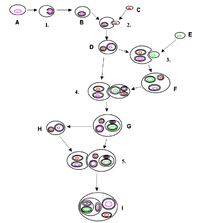
Photo from wikipedia
Previous studies have shown the sugarcane microbiome harbors diverse plant growth promoting microorganisms, including nitrogen-fixing bacteria (diazotrophs), which can serve as biofertilizers. The genomes of 22 diazotrophs from Colombian sugarcane… Click to show full abstract
Previous studies have shown the sugarcane microbiome harbors diverse plant growth promoting microorganisms, including nitrogen-fixing bacteria (diazotrophs), which can serve as biofertilizers. The genomes of 22 diazotrophs from Colombian sugarcane fields were sequenced to investigate potential biofertilizers. A genome-enabled computational phenotyping approach was developed to prioritize sugarcane associated diazotrophs according to their potential as biofertilizers. This method selects isolates that have potential for nitrogen fixation and other plant growth promoting (PGP) phenotypes while showing low risk for virulence and antibiotic resistance. Intact nitrogenase (nif) genes and operons were found in 18 of the isolates. Isolates also encode phosphate solubilization and siderophore production operons, and other PGP genes. The majority of sugarcane isolates showed uniformly low predicted virulence and antibiotic resistance compared to clinical isolates. Six strains with the highest overall genotype scores were experimentally evaluated for nitrogen fixation, phosphate solubilization, and the production of siderophores, gibberellic acid, and indole acetic acid. Results from the biochemical assays were consistent and validated computational phenotype predictions. A genotypic and phenotypic threshold was observed that separated strains by their potential for PGP versus predicted pathogenicity. Our results indicate that computational phenotyping is a promising tool for the assessment of bacteria detected in agricultural ecosystems.
Journal Title: Scientific Reports
Year Published: 2021
Link to full text (if available)
Share on Social Media: Sign Up to like & get
recommendations!